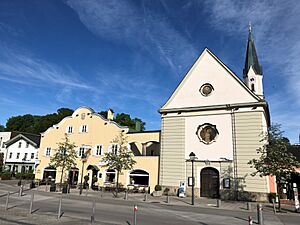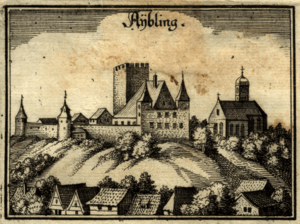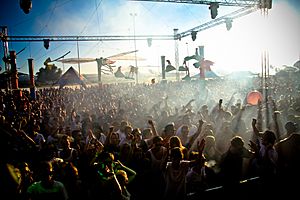Bad Aibling facts for kids
Quick facts for kids
Bad Aibling
|
||
|---|---|---|

The former Prantshausen castle and the Church of Saint Sebastian
|
||
|
||
| Country | Germany | |
| State | Bavaria | |
| Admin. region | Upper Bavaria | |
| District | Rosenheim | |
| Elevation | 492 m (1,614 ft) | |
| Population
(2022-12-31)
|
||
| • Total | 19,613 | |
| Time zone | CET/CEST (UTC+1/+2) | |
| Postal codes |
83035–83043
|
|
| Dialling codes | 08061 | |
| Vehicle registration | RO, AIB | |
Bad Aibling is a special kind of town in Bavaria, Germany. It's known as a spa town, which means it's a place where people go to relax and get healthy using natural waters and mud. It's located about 56 kilometers (35 miles) southeast of Munich, right by the Mangfall river.
The town has a fancy health resort. Here, visitors can enjoy special treatments like peat pulp baths (baths made with a type of natural mud) and mineral spas (baths with water full of healthy minerals).
Contents
Discovering Bad Aibling's Past
Bad Aibling has a long and interesting history! People first lived here a very long time ago.
Early Settlements and Roman Times
Around 500 BC, Celtic tribes made their homes in Bad Aibling and the areas nearby. They lived here until about 15 BC. After that, the Romans took over for a while. Finally, in the 5th century AD, tribes called the Bavarii settled in the area.
The town was first mentioned in old writings in the year 804. Back then, it was called "Epininga."
Medieval Period and Spa Beginnings
During the Middle Ages, Bad Aibling was an important center for the Counts of Falkenstein. In 1166, it was called "Aibilingen" in an old document. Later, when the Falkenstein family's rule ended, the town became part of the land owned by the powerful Wittelsbach family.
A big change happened in 1845. A doctor named Desiderius Beck started offering the first treatments using peat pulp. This natural mud was thought to be very good for health. Because of these popular health treatments, Bad Aibling officially received the title "Bad" (which means "spa" or "springs") in 1895.
Becoming a Town and Post-War Changes
In 1933, Bad Aibling officially became a town. After World War II, the town played a role in helping people. It was a place where German prisoners of war (POWs) were released.
In 1946, a camp was set up for people who had been forced to leave their homes during the war. This camp, called the IRO Children's Village, was especially for children and young people who didn't have their parents with them. Over 2,300 children from many different countries stayed there before it closed in 1951.
Later, the area became a secret center for intelligence groups.
Modern Developments and Events
In 2005, a big American listening station called ECHELON (also known as Field Station 81) closed down after many years. After the NSA left, parts of the station were used by Germany's own intelligence service, the Bundesnachrichtendienst (BND). The large dome-shaped buildings, called radomes, are still used today.
In 2007, a new modern spa called the Thermae opened. It uses mineral water from a special spring called the Desiderius-Quelle, adding to the traditional peat pulp baths. Sadly, in the same year, the historic Ludwigsbad spa hotel, which was very important to Bad Aibling's health resort history, burned down.
On February 9, 2016, a sad train accident happened near the town. Two passenger trains crashed, and 11 people lost their lives.
Bad Aibling's Location and People
Bad Aibling is home to about 18,000 people. It sits about 498 meters (1,634 feet) above sea level and covers an area of 41.55 square kilometers (16.04 square miles).
Neighborhoods of Bad Aibling
The town is made up of many different neighborhoods, also called Stadtteile. Some of these include Abel, Adlfurt, Bad Aibling Mitte, Berbling, Ellmosen, Fachendorf, Gröben, Harthausen, Haslach, Heimathsberg, Heinrichsdorf, Holzhausen, Köckbrunn, Markfeld, Mietraching, Mitterham, Moos, Natternberg, Thalacker, Thürham, Unterheufeld, Weg, Westen, Westerham, Willing, and Zell.
Economy and Town Services
Bad Aibling's economy is strongly linked to its health and wellness services.
Health and Wellness Businesses
Many large spa hotels and hospitals that help people recover are located here. They use peat pulp as a main treatment. The new thermae, which opened in 2007, also attract many visitors.
Local Companies
Several companies in different industries have their base in Bad Aibling. These include businesses in:
- Making medicines (pharmaceutical industry)
- Producing fabrics (textile manufacturing)
- Working with electricity (electrical engineering)
- Creating plastic products (plastics manufacturing)
- Processing milk (dairy processing)
Public Services and Offices
The town has various public services to help its citizens:
- Local government offices
- The employment office for Bad Aibling
- Offices for the Rosenheim district, like the animal health office and car registration
- A local court
- The Bundesnachrichtendienst (BND), which is Germany's intelligence agency
Education in Bad Aibling
Bad Aibling offers many educational opportunities for students of all ages:
- German football boarding school (Deutsches Fußballinternat Bad Aibling)
- Gymnasium Bad Aibling (a high school that prepares students for university)
- Wilhelm-Leibl-Realschule (another type of secondary school)
- Wirtschaftsschule Alpenland (a secondary school focused on economics)
- Grund- und Hauptschulen (primary and secondary schools)
- Sonderschule (a primary and secondary school for children with special needs)
- Volkshochschule Bad Aibling (adult evening classes for learning new skills)
How Many People Live Here?
The number of people living in Bad Aibling has grown over the years:
- 1840: 2,597 people
- 1900: 5,181 people
- 1950: 10,908 people
- 2000: 16,437 people
- 2015: 18,408 people
Fun Things to Do and See
Echelon Festival
The Echelon Open Air & Indoor Festival is a big music event that happens every August in Bad Aibling. It features electro, techno, and house music. In 2015, about 25,000 people attended, making it the largest festival of its kind in Bavaria! It takes place at the old Bad Aibling Station, which was once used for the famous global surveillance network called ECHELON.
Sister City
Bad Aibling has a special friendship with another town far away. Since 2006, it has been twinned with:
 Cavaion Veronese, a town in Italy.
Cavaion Veronese, a town in Italy.
Famous People from Bad Aibling
Many interesting people have connections to Bad Aibling:
- Desiderius Beck (around 1804–1877), a Bavarian court doctor who started the first peat mud baths in Bad Aibling.
- Amelie Kober (born 1987), a German police officer and an Olympic medalist in snowboarding.
- Wilhelm Leibl (1844–1900), a German painter known for his realistic portraits and scenes of everyday life.
- Johann Sperl (1840–1914), another German painter.
- Julian Weigl (born 1995), a German football player who plays for Sport Lisboa e Benfica.
Images for kids
See also
 In Spanish: Bad Aibling para niños
In Spanish: Bad Aibling para niños






















